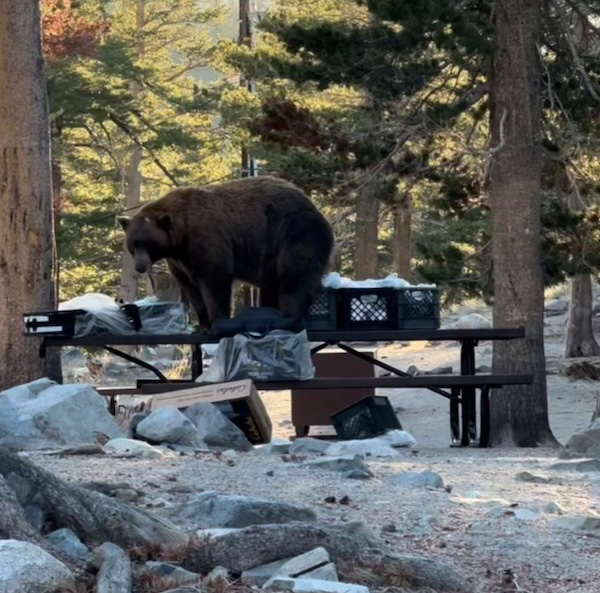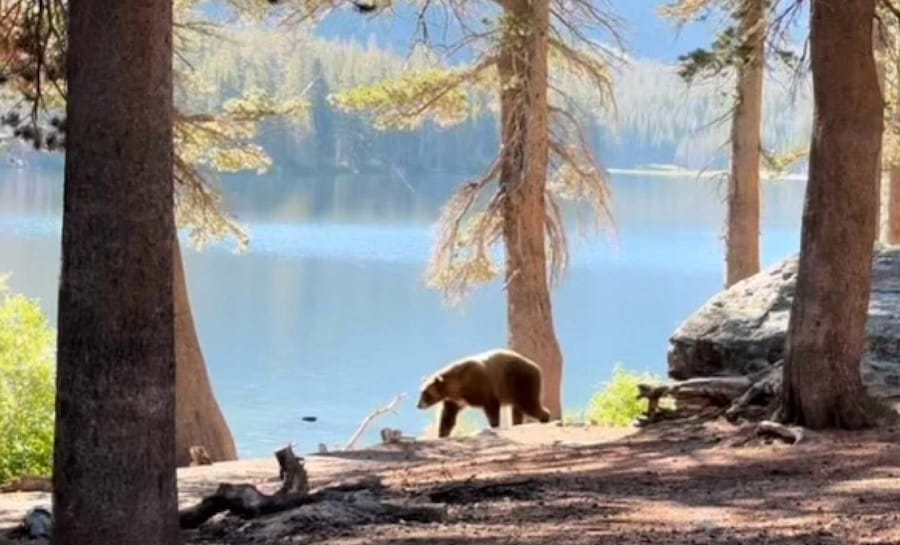A California Town’s Beloved 400-pound Bear Attacked a Woman. Now He’s Dead, and Locals Want Justice
The killing of a large bear known to raid campsites near the Sierra tourist town of Mammoth Lakes has sparked an outcry that many hope will change how state and federal officials manage California’s growing population of habituated black bears and also deal with people who encounter them.

"The Disneyesque fantasy of bears and wolves as ‘cute and cuddly’ usually ends in tragedy for both the animals and the people who project human traits, emotions, or intentions onto these very dangerous animals.
NOTE: this article was originally published to San Francisco Chronicle's Apple News Channel on August 30, 2024. It was written by Gregory Thomas. Photo credits are given to Delaney Pric.
A 400-pound adult black bear known to Mammoth locals as “Victor” for a v-shaped patch of light fur on his chest, had for years been a frequent sight around Lake Mary, where he scavenged for food left out by campers during peak summer months. That troubling behavior aside, some locals have described the bear as a pleasant and exciting feature of the lake basin.
In recent years, though, the bear became bolder and seemingly unafraid of humans — approaching groups of people to nose into open food coolers on the lake shore, moseying through packed campgrounds during dinner hour and even charging campers standing near bear-proof food-storage boxes, according to Delaney Prince, a camp host at the Pine City Campground.
That behavior culminated in a campsite incident on Aug. 21 that ultimately prompted state officials to track down the bear and euthanize it a day later.
In a video of the encounter posted to social media, the bear disrupts a camping group’s steak dinner, scaring away campers and then eating off of their picnic table. Campers can be heard banging objects together in an attempt to spook the bear, but to no avail. Then the bear turns to inspect a nearby bear box and a woman in the group can be seen standing on a tree stump a few feet away from the animal apparently to film it eating. As the creature registers the woman, it swipes her lower leg with its paw, and the woman screams, then hops off the stump and scurries away.
“Holy sh—!” one of the campers yells offscreen.
The woman suffered “a severe and very deep laceration into her calf muscle” and was treated at a nearby hospital later that evening, according to Capt. Patrick Foy of the California Department of Fish and Wildlife’s Law Enforcement Division.
The bear had already been on the state’s radar for its aggressive behavior. Earlier in the August at a different campground on Lake Mary, the animal swiped a man who attempted to take a selfie by it, leaving the man with two puncture wounds in his leg, Foy said. State wildlife officials who investigated that encounter concluded that the human, in that case, “potentially instigated the bear to react the way it did” and took no further action, Foy said.

However, after investigating the campsite incident, state wildlife officials concluded that the woman on the tree stump had “attempted to escape” the bear before it swiped her, and were compelled to act, Foy said. The day after, they found the bear at a nearby campground, tranquilized it, took a DNA sample for testing, confirmed its identity “with a high level of confidence,” and euthanized it with a lethal drug injection, Foy said.
Officials then transported the large carcass to a landfill in Bishop, where it was buried using a loader.
Wildlife officials prefer to place dead animals deep in the forest where they can decompose in a natural setting, Foy said. But a creature with sedatives and deadly drugs in its system poses a toxic hazard to other wildlife, so officials instead arrange a landfill burial or incineration.
The bear’s death was complicated when a photo showing its corpse resting unceremoniously on the ground at the landfill — taken while its grave was being dug nearby, Foy said — was posted and disseminated online.
The episode has touched off a debate about who should be held responsible for the bear’s demise and left some people in disbelief that a wild animal known fondly by many locals could wind up dead at a garbage dump.
The campsite video and landfill photo were shared early by Steve Searles, a former wildlife officer for the town of Mammoth Lakes known as “The Bear Whisperer” for his decades of work managing animals — including Victor — around the basin. After hearing first-hand accounts of the swiping from other campers who witnessed the incident, Searles has come to believe the campers baited their site with food for multiple nights to draw the bear out and film a wildlife encounter.
Authorities did not address Searles’ allegations, and the campers could not be identified or reached for comment.
Hundreds of commenters on social media have excoriated the campers: “It’s always the animals that pay the price for stupid humans,” one Facebook person commented on one of Searles’ posts.
A Change.org petition called “Justice for Victor the Bear,” created Tuesday by a Mammoth Lakes local, calls for the campers “to be fined” and for authorities “to handle this differently as well as assurance that this will not happen again.” By Friday afternoon, the petition had garnered more than 6,300 signatures.

The bear’s outcome didn’t sit well with at least one of the several indigenous communities native to the Southern Sierra.
Upon learning of the animal’s fate, Steven Orihuela, tribal council chairman of the Bishop Paiute Tribe, intervened and got permission to exhume the bear’s carcass from the landfill and rebury it on tribal land.
“My number one priority was, we gotta bring him home and give him a proper burial,” said Orihuela, using the word “Pahabichi,” the tribe’s language for bear.
Tribespeople present for the reburial submitted prayers and offerings and sang songs to honor the animal, Orihuela said. “The bear is akin to an aunty for us because they’re healers for the land and they’re always watching out for us,” he said.
The tribe intends to meet with state wildlife officials this coming week to discuss the incident and, Orihuela hopes, create an understanding that tribes should be included in such affairs going forward “so they can honor their (bear) relatives in a timely manner and in ways that are culturally aware to their respective tribe” — not just in Mammoth Lakes, but statewide.
Foy said the state could benefit from hearing the tribe’s perspective.
“This is a conversation we need to have and we’re more than willing to engage,” Foy said. “We intend to get a sense of what the tribe would do. … We want to do everything we can to help people and bears coexist and prevent this from happening again. I think we’re all on the same page about that.”
